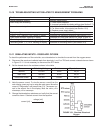
100
MODEL 54eA SECTION 15.0
TROUBLESHOOTING
15.10 TROUBLESHOOTING NOT RELATED TO MEASUREMENT PROBLEMS
Problem Action
Display segments missing Replace display board
Alarm relays are chattering 1. Check alarm setpoints.
2. Increase hysteresis time delay settings (see Section 5.7)
Incorrect current output 1. Verify that output load is less than 600 Ω.
2. For minor errors, trim outputs (see Section 13.0)
3. Replace power supply board
Display too light or too dark Change contrast (see Section 5.5)
“Level 1, 2 or 3 security: Lock” shown in display Controller has password protection (see Section 5.13)
“Hold mode activated” showing in display Controller is in hold (see Section 5.6, steps 10 and 11)
“Simulating output 1 or 2” showing in display Controller is simulating outputs (see Section 5.4)
“Simulating alarm 1, 2, 3 or 4” showing in display Controller is simulating alarms (see Section 5.4)
15.11 SIMULATING INPUTS - DISSOLVED OXYGEN
To check the performance of the controller, use a decade box to simulate the current from the oxygen sensor.
A. Disconnect the anode and cathode leads from terminals 1 and 2 on TB3 and connect a decade box as shown
in Figure 15-1. It is not necessary to disconnect the RTD leads.
B. Set the decade box to the resistance shown in the table.
C. Note the sensor current. To view the sensor current from the
main display, press any key to enter the main menu. Move the
cursor to "Diagnostics" and press Enter (F4). The sensor cur-
rent is the second line in the display. Note the units: μAis
microamps, nA is nanoamps.
D. Change the decade box resistance and verify that the correct
current is shown. Calculate current from the equation:
current (μA) =
Sensor Polarizing Voltage Resistance Expected current
499ADO -675 mV 34 kΩ 20 μA
499A TrDO -800 mV 20 kΩ 40 μA
Hx438 and Gx448 -675 mV 8.4 MΩ 80 nA
voltage (mV)
resistance (kΩ)
FIGURE 15-1. Simulate Dissolved
Oxygen


















